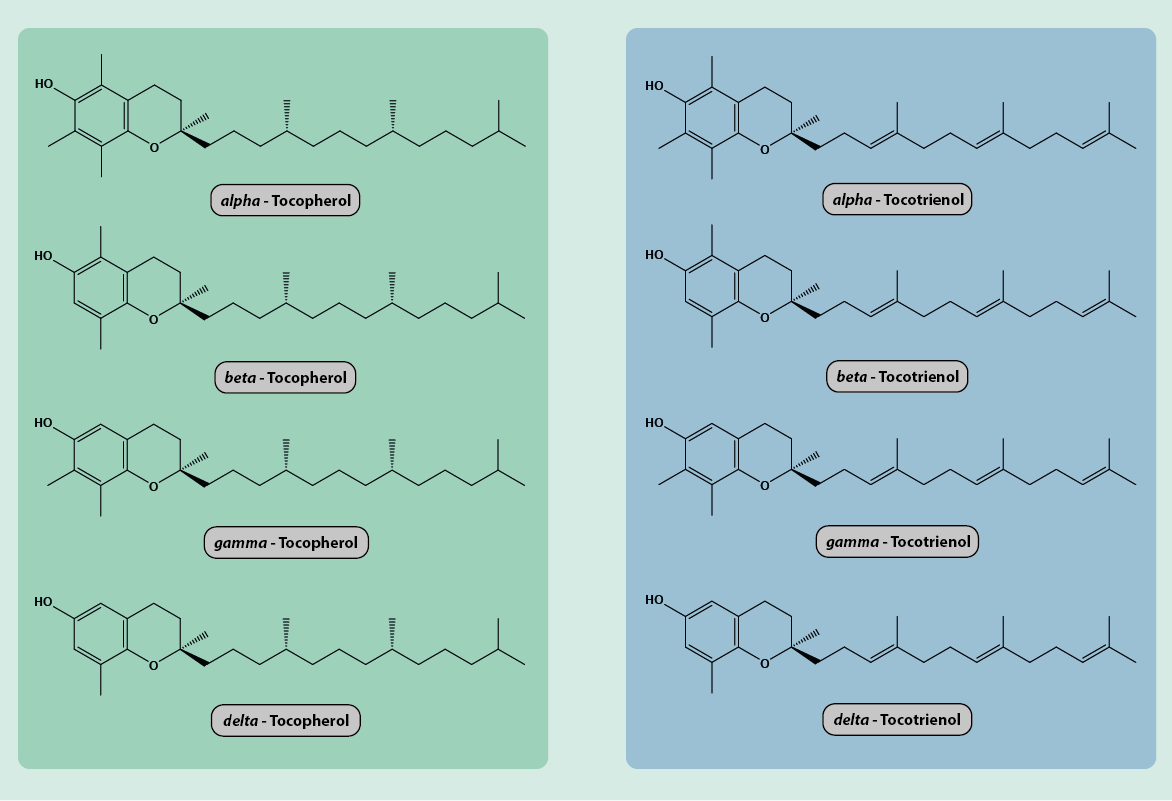Tocopherol
Natural vitamin E is a mixture of a number of closely related compounds, tocopherols and tocotrienols (Figure 1). The fat-soluble vitamin E is found in high concentrations in plant-derived oils and fats. In these inanimate substances, the role of this mixture of tocopherols and tocotrienols is to act as antioxidants preventing the oils / fats from going rancid. Vitamin E, together with ascorbic acid (vitamin C), is well researched in this role as chemical food preservative. Synthetic ‘vitamin E’ is made up of a single component, α-tocopherol.

The exact role of tocopherols and/or tocotrienols in living biological systems, including humans, is much less clear and a matter of debate with a wide range of opinions. The only point where there is consensus, is that α-tocopherol is the one component of vitamin E that is most readily absorbed in the human intestines, although there is no clear agreement as to why that is the case. There is also general agreement that vitamin E deficiency is very rare. If it occurs, it causes neuronal dysfunctions, but any vitamin E deficiency is easily counteracted by appropriate dietary adjustments.
The views on the biochemical mechanism and physiological role(s) of vitamin E / tocopherol(s) in the human body are extremely diverse. Views include those that translate the purely antioxidative chemical role of tocopherols in inanimate substances to an analogous function in the living human body. Other views highlight anti-inflammatory properties, potential neuroprotection, immunomodulation and antiallergic effects, where overall the antioxidative properties are taken as secondary. A logical argument supporting this view is that there are many regulated controls in the body’s healthy physiology that maintain the correct levels of antioxidant substances. It is important to keep these concentrations in an appropriate range as there are many physiological functions that depend on radicals (for example, the role of NO in haemostasis) and are essential for the functioning of the body. This may explain, for example, the fast metabolization of several of the vitamin E components after ingestion. Many arguments are derived from in vitro laboratory experiments, often employing tocopherol / tocotrienol concentrations much higher than under physiological conditions.
Accordingly, the views on the potential advantages and disadvantages of tocopherols / tocotrienols in the prevention and treatment of diseases is equally conflicted.
We discuss tocopherol here because it is one of the three components in the so called ‘triple therapy’ (or PENTOCLO), a controversial medication scheme originally proposed for the treatment of soft-tissue necrosis following radiotherapy treatment for breast cancer and later also advertised for the treatment of osteoradionecrosis. Osteoradionecrosis is a severe long-term (life-long) risk following radiotherapy in the head & neck region. The cocktail of drugs consists of pentoxifylline, tocopherol and clodronate. The argument to include tocopherol in the cocktail is based on its assumed antioxidative properties. The evidence base about the working principles of this medication scheme and the related hypotheses about the pathology of osteoradionecrosis are conflicted. It is worth mentioning that in the UK the National Institute for Health and Care Excellence (NICE) only recommends PENTOCLO / ‘triple therapy’ for the treatment of osteoradonecrosis of the jaws in the framework of clinical trials but not otherwise.